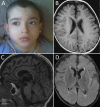GRIN2A mutation and early-onset epileptic encephalopathy: personalized therapy with memantine
- PMID: 24839611
- PMCID: PMC4019449
- DOI: 10.1002/acn3.39
GRIN2A mutation and early-onset epileptic encephalopathy: personalized therapy with memantine
Abstract
Objective: Early-onset epileptic encephalopathies have been associated with de novo mutations of numerous ion channel genes. We employed techniques of modern translational medicine to identify a disease-causing mutation, analyze its altered behavior, and screen for therapeutic compounds to treat the proband.
Methods: Three modern translational medicine tools were utilized: 1) high-throughput sequencing technology to identify a novel de novo mutation; 2) in vitro expression and electrophysiology assays to confirm the variant protein's dysfunction; and 3) screening of existing drug libraries to identify potential therapeutic compounds.
Results: A de novo GRIN2A missense mutation (c.2434C>A; p.L812M) increased the charge transfer mediated by NMDA receptors containing the mutant GluN2A-L812M subunit. In vitro analysis with NMDA receptor blockers indicated that GLuN2A-L812M-containing NMDARs retained their sensitivity to the use-dependent channel blocker memantine; while screening of a previously reported GRIN2A mutation (N615K) with these compounds produced contrasting results. Consistent with these data, adjunct memantine therapy reduced our proband's seizure burden.
Interpretation: This case exemplifies the potential for personalized genomics and therapeutics to be utilized for the early diagnosis and treatment of infantile-onset neurological disease.
Figures




Similar articles
-
The human NMDA receptor GluN2AN615K variant influences channel blocker potency.Pharmacol Res Perspect. 2019 Jun 20;7(4):e00495. doi: 10.1002/prp2.495. eCollection 2019 Aug. Pharmacol Res Perspect. 2019. PMID: 31249692 Free PMC article.
-
Effect of a GRIN2A de novo mutation associated with epilepsy and intellectual disability on NMDA receptor currents and Mg(2+) block in cultured primary cortical neurons.Lancet. 2015 Feb 26;385 Suppl 1:S65. doi: 10.1016/S0140-6736(15)60380-4. Lancet. 2015. PMID: 26312887
-
Functional analysis of a de novo GRIN2A missense mutation associated with early-onset epileptic encephalopathy.Nat Commun. 2014;5:3251. doi: 10.1038/ncomms4251. Nat Commun. 2014. PMID: 24504326 Free PMC article.
-
Identifying mutations in epilepsy genes: Impact on treatment selection.Epilepsy Res. 2019 May;152:18-30. doi: 10.1016/j.eplepsyres.2019.03.001. Epub 2019 Mar 4. Epilepsy Res. 2019. PMID: 30870728 Review.
-
Recurrent and Non-Recurrent Mutations of SCN8A in Epileptic Encephalopathy.Front Neurol. 2015 May 15;6:104. doi: 10.3389/fneur.2015.00104. eCollection 2015. Front Neurol. 2015. PMID: 26029160 Free PMC article. Review.
Cited by
-
2014 Epilepsy Benchmarks Area I: Understanding the Causes of the Epilepsies and Epilepsy-Related Neurologic, Psychiatric, and Somatic Conditions.Epilepsy Curr. 2016 May-Jun;16(3):182-6. doi: 10.5698/1535-7511-16.3.182. Epilepsy Curr. 2016. PMID: 27330450 Free PMC article. No abstract available.
-
Modelling and treating GRIN2A developmental and epileptic encephalopathy in mice.Brain. 2020 Jul 1;143(7):2039-2057. doi: 10.1093/brain/awaa147. Brain. 2020. PMID: 32577763 Free PMC article.
-
Functional Investigation of a GRIN2A Variant Associated with Rolandic Epilepsy.Neurosci Bull. 2018 Apr;34(2):237-246. doi: 10.1007/s12264-017-0182-6. Epub 2017 Sep 21. Neurosci Bull. 2018. PMID: 28936771 Free PMC article.
-
Defining Disease, Diagnosis, and Translational Medicine within a Homeostatic Perturbation Paradigm: The National Institutes of Health Undiagnosed Diseases Program Experience.Front Med (Lausanne). 2017 May 26;4:62. doi: 10.3389/fmed.2017.00062. eCollection 2017. Front Med (Lausanne). 2017. PMID: 28603714 Free PMC article.
-
Rational Small Molecule Treatment for Genetic Epilepsies.Neurotherapeutics. 2021 Jul;18(3):1490-1499. doi: 10.1007/s13311-021-01110-w. Epub 2021 Aug 24. Neurotherapeutics. 2021. PMID: 34431030 Free PMC article. Review.
References
-
- Reutlinger C, Helbig I, Gawelczyk B, et al. Deletions in 16p13 including GRIN2A in patients with intellectual disability, various dysmorphic features, and seizure disorders of the rolandic region. Epilepsia. 2010;51:1870–1873. - PubMed
-
- Endele S, Rosenberger G, Geider K, et al. Mutations in GRIN2A and GRIN2B encoding regulatory subunits of NMDA receptors cause variable neurodevelopmental phenotypes. Nat Genet. 2010;42:1021–1026. - PubMed
-
- de Ligt J, Willemsen MH, van Bon BW, et al. Diagnostic exome sequencing in persons with severe intellectual disability. N Engl J Med. 2012;20:1921–1929. - PubMed
Grants and funding
LinkOut - more resources
Full Text Sources
Other Literature Sources
Miscellaneous

